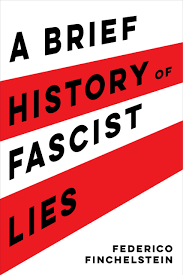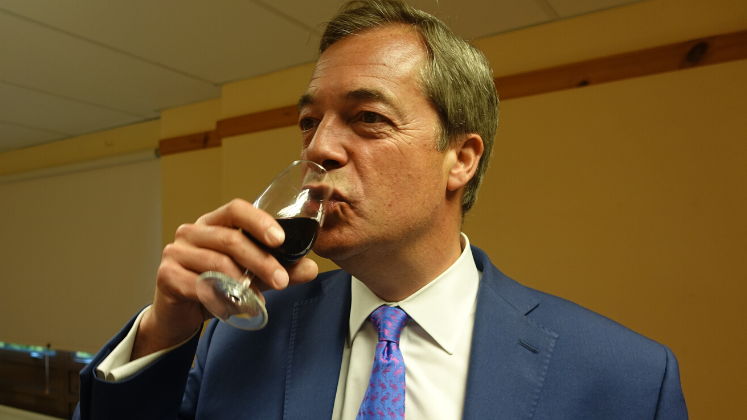In A Brief History of Fascist Lies, Federico Finchelstein offers a new historical examination of how fascism does not just embrace lies, but integrates them into a distinctive, irrational structure of ‘truth’ that serves its political ends. This is a worthwhile read that provides a clear and lucid overview of how fascism perceives ‘truth’, reason and leadership, writes Ben Margulies, and will be particularly useful for undergraduate and postgraduate students of politics.
A Brief History of Fascist Lies. Federico Finchelstein. University of California Press. 2019.
 One of the central lessons of the twentieth century is that lying is a key tool of totalitarian government. Secondary-school students the world over absorb this lesson through the works of George Orwell. The Nazi leader Adolf Hitler and propagandist Joseph Goebbels are frequently quoted about the power of ‘the big lie’. Most laypeople could explain how autocratic governments can exert control through untruth (especially if they happen to also favour conspiracy theories).
One of the central lessons of the twentieth century is that lying is a key tool of totalitarian government. Secondary-school students the world over absorb this lesson through the works of George Orwell. The Nazi leader Adolf Hitler and propagandist Joseph Goebbels are frequently quoted about the power of ‘the big lie’. Most laypeople could explain how autocratic governments can exert control through untruth (especially if they happen to also favour conspiracy theories).
This popular understanding is entirely correct. However, it leaves certain questions unexamined. Do totalitarian rulers believe their own lies? How do they justify their mendacity? And what is the relation between bald-faced, opportunistic lying and ideology, a set of strong normative beliefs about the way things should be? In this slim volume, A Brief History of Fascist Lies, Argentine historian Federico Finchelstein examines these questions in relation to fascism. The result is a lucid examination of how fascism does not just embrace lies, but integrates them into a distinctive, irrational structure of ‘truth’ that serves its political ends. Finchelstein’s key arguments are immensely valuable to our understanding of contemporary politics, even though his book suffers from some stylistic flaws.
Finchelstein is a scholar of fascism and populism. In his previous book, From Fascism to Populism in History, he traced the transition from the former to the latter, which he argues began in Latin America with Peronism and similar movements. Fascism proposed a ‘true democracy’ through a spiritual communion between people, state and leader in an authoritarian order. Finchelstein argued that populism preserved this political union and authoritarian impulse in a democratic, electoral frame. Finchelstein added that fascism is expressly violent; populism, generally, is not.
In A Brief History of Fascist Lies, Finchelstein focuses more specifically on fascism, which he defines as ‘a modern counterrevolutionary formation […] ultranationalist, antiliberal and anti-Marxist’ (22). He stresses its character as a ‘transnational phenomenon both inside and outside Europe’ (22), citing many fascist sources from Latin America, as well as the work of critics including Jorge Luis Borges.

Image Credit: Crop of Photo by Paweł Czerwiński on Unsplash
At the core of the book lies Finchelstein’s understanding of how fascists historically defined truth. To fascists, what was ‘true’ was not what was empirically verifiable. Rather, ‘fascism proposed the notion of truth that transcended reason and was incarnated in the myth of the leader’ (28). Truth stemmed from atavistic, primordial myths, from spiritual truths, more normative than real. ‘In fascism, truth was considered real because it was rooted in emotional emanations of the soul, images and actions that fascists identified with political ideology’ (53). So, for fascists, ‘lies’ were not so much denials of the truth, as rejections of the ‘real world’ in favour of an idealised one fitting their spiritual beliefs about what should be. They were statements of faith in a deeper ‘truth’.
Fascists contended that this deeper spiritual truth could only be ascertained instinctively and irrationally: ‘the idea that the soul had an authentic inner notion of the world was at the center of the fascist intellectual process’ (58). Finchelstein devotes a chapter to the fascist reaction to psychoanalysis. Fascists recoiled at the idea of rationally examining the subconscious or the personality; ‘fascism renounced self-awareness and put in its place a Godly truth supposedly emanating from a purified self’ (63). They reacted with horror to the idea that the subconscious might be a source of disorder or wanton desire, and condemned Sigmund Freud because he ‘questioned the idea of the sacred [in the sense of locating it in the human psyche] and therefore the politics that fascism represented’ (66). Fascists also demonised psychoanalysis through antisemitic claims that it was a Jewish plot against the people or race.
Finchelstein emphasises the role of the fascist leader. It was the leader’s role to excavate, interpret and propagate this soul-myth from deep inside the collective people. ‘Only the leader was the ideal representation of sovereign desires’ (58); he ‘acted as the best expression of the people’s ideal self’ (60). In the fascist imaginarium, the leader derived these truths from some deep spiritual foundation, but Finchelstein points out that often what he was really drawing on was the desires – the ids, to use a Freudian term – of their constituents: ‘Their primary aim was the fulfilment of their followers’ repressed destructive desires’ (88).
Fascists did not only believe that truth drew from some irrational mythical source. It also animated their political practice. Their goal was to refashion reality in accordance with their own mythos, usually through the violent realisation of their desires, which is why political violence was so important. ‘Power derived from the affirmation of myth through violence, destruction and conquest’ (26), confirming the fascist mythos by forcing reality to surrender to sacralised prejudices. Fascism’s goal was to ‘make lies true’. This reworking of the world was also retrospective, as fascists energetically refashioned history according to mythos.
Finchelstein’s book explains these important points with great clarity and power. However, it has an unfortunate tendency to explain them over and over again, in somewhat different configurations (also a problem with From Fascism to Populism in History). The key points of the text are straightforward enough to fill a reasonably long journal article. Over the course of almost 100 pages, it feels like Finchelstein is reprising them in every chapter.
Finchelstein makes heavy use of various fascist writers to explain their ideological conception of truth. This is effective, but it also snags the flow of the text; it sometimes feels like reading a compilation of different quotes. It’s also unclear why Finchelstein has chosen the particular sources he has.
Finchelstein’s final chapter deals with the role of lies in modern-day populism – perhaps the subject his readers will be most interested in. Here, he refers to US President Donald Trump and Brazilian President Jair Bolsonaro. He discusses the way Trump’s followers see him as a source of truth and a divinely elected leader (92-94; 98), and he accuses Bolsonaro of attempting to redefine the meaning of dictatorship and Brazil’s political history in order to justify his authoritarian project (98-100).
Here, however, Finchelstein’s evidence base is relatively thin. He cites very few populist leaders and their statements and compares them to those of classical fascism; he also notes how ‘fascism and populism both appeal to the political trinity, leader, nation and people, as their main source of legitimation’ (96). However, he does not engage with any of the voluminous literature on populism and its models of leadership in the way he does with fascism (in the rest of the book, he cites fascist thinkers and their critics like Hannah Arendt, Theodor Adorno and Borges). The chapter makes a few brief comparisons while making a largely unexamined assumption about the similarities between fascism and populism. I find that assumption very credible, but Finchelstein needed to provide more evidence for it (Catherine Fieschi’s Populocracy deals with similar questions regarding reason and truth, though it was published after the release of this book).
For all these flaws, Finchelstein’s book is very much a worthwhile read. It provides a simple, lucid overview of how fascists ‘lie’, or more precisely, how fascists perceive ‘truth’, reason and leadership. As a guide to understanding how fascists – and perhaps many other kinds of right-wing political activists – think, it is immensely helpful. I would recommend it for politics undergraduate and postgraduate courses.
Note: This review gives the views of the author, and not the position of the LSE Review of Books blog, or of the London School of Economics and Political Science.








Thanks for the review. Good analysis.